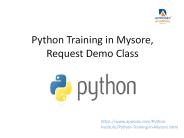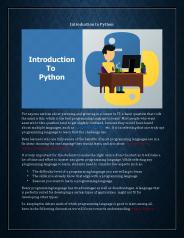Python - PowerPoint PPT Presentation
1 / 32
Title: Python
1
Python
- November 18, Unit 7
2
So Far
- We can get user input
- We can create variables
- We can convert values from one type to another
using functions - We can use conditionals
- We can import new modules with specific functions
we need
3
Whats Next?- Iteration
- With our random number program were only able to
let the user guess once before having to restart
the program - But in a real guessing game hopefully the user
would be able to keep guessing until they found
the answer - How can we do this?
- Use iteration
4
Iteration
- Iteration allows us to write programs that repeat
some code over and over again - The easiest form of iteration is using a while
loop - While loops read a lot like English (like almost
everything in Python) - While counter is greater than 0, execute some
code - While userguess does not equal my number, keep
asking for a new number
5
While Loop
- While loops are like if, elif, and else
statements in that only the indented code is part
of the loop - Be careful with indentation
- Like if and elif statements, while loops must
check to see if some condition is true - While its true, execute some code
- When its not true, exit the loop
6
Simple While Loop Example
- Lets write a while loop that prints the numbers
from 1 to 10 - i 1 initialize i 1
- while ilt10 execute the code in the loop
- print i until i gt10
- i i 1 increment i
- print all done!
7
Another While Loop Example
- count 1
- num 3
- while countlt5
- print numcount
- count count1
- this prints 3, 6, 9, 12
8
Variation on Last While Loop
- num 3
- while numlt12
- print num
- num num3
- this loop also prints 3, 6, 9, 12
9
In-Class Example
- Adding a while loop to our random program
10
While loops, cont.
- Now our user can keep guessing until they get the
right answer - But they can still only play once
- We can add another while loop to allow the user
to continue playing - In-Class Example
11
Counters
- Often when creating and using while loops we need
to keep count of how many times the loop has
executed - Usually used as the test condition for the while
loop - Ex.
- count 1
- while countlt10
- print I love cmpt165
- count count1
- In this simple example, count is referred to as
the counter
12
Counters, cont.
- Counters can be used as part of the body of the
while loop - The counter can be used for more than counting
- Counters are often given a variable name of a
single character - i
- j
- k
- a
- b
- Etc.
13
Counters, cont.
- We dont always need counters
- count 1
- num 3
- while countlt5
- print numcount
- count count1
- num 3
- while numlt12
- print num
- num num3
14
Functions
- Weve been using many functions so far
- raw_input
- type
- int, float, str
- random.randint
- So what is a function?
- Sequence of code which performs a specific task
15
Functions, cont.
- Functions often take arguments
- This is what you have to put inside the
parentheses - For example, raw input takes in a string
- raw_input (enter your name)
- Takes in is another way of saying it takes an
argument, in this case a string - Functions often return a value
- This is what you get back when you call the
function - For example, raw_input returns a string
- int() returns an integer
- float() returns a float
16
Creating New Functions
- We dont have to rely on only the functions in
the Python library - We can have functions that do almost anything
- Can be as simple as adding 2 to a number
- Why use functions?
- Makes our code easier to read
- Lets us repeat code more efficiently
17
Creating a New Function
- The syntax for creating a new function is
- def functionName(arguments)
- Lets define a function called printName that
takes in a string - def printName(userName)
- Like with if, elif, else, and while blocks,
indentation is important - The function is the code indented immediately
following the function definition
18
Simple Function
- Lets create a function that does one thing,
prints CMPT 165 - def printWord()
- print CMPT165!!!
- To call this function we simply use its name
- printWord()
- This function takes in no arguments and returns
no values - All it does when we call it is print the string
CMPT165
19
In-Class
- Trying the last function in class
- Adding a while loop to it
20
Changing our printWord()
- printWord is a pretty boring function
- Again it has no arguments and returns nothing
- So, lets change it so that we can give it any
string to print - def printWord(wordToPrint)
- print wordToPrint
- Now when we call this function we have to provide
something for it to print - printWord(CMPT165 Rules!)
21
In-Class
- Changing printWord to take in a string
22
Passing Values into Functions
- The function printWord takes in the argument
wordToPrint - wordToPrint is a variable
- When we call the function printWord, whatever
value we put inside the () is the value that the
function uses - printWord(butterfly)
- printWord(peanut)
- printWord(24) prints 6
- The value in parenthesis in the function call is
assigned to the argument variable
23
Functions with Multiple Arguments
- We can have functions with many arguments
- As many as we want
- Lets do a math example where we want to do some
fancy math - def fancyMath(a,b)
- c abb/ (ab) ba
- print c
24
fancyMath(a,b), cont.
- fancyMath takes in two arguments
- Need to be numbers (either ints or floats)
- When we call the function fancyMath we have to
put in two values for a and b - fancyMath(2,3)
- fancyMath(5.0,1)
- fancyMath(num1, 3)
- fancyMath(num1, num2)
- We can use integers, floats, or variables
- And any combination thereof
- Remember that the value we pass into the function
gets stored in the variables a and b
25
In-Class
- Using fancyMath
26
Return Values
- Functions can take in any number of arguments
- From 0 -gtwhatever you want
- But functions can only return one value
- To return a value we use the return keyword
- We an return numbers, strings, and any values
stored in variables
27
Adding Return to fancyMath
- Right now fancyMath prints the value of c
- Has the result of our fancy math calculation
- Instead, lets have it return the value so we can
do something else with it in the main part of the
program - def fancyMath(a,b)
- c abb/ (ab) ba
- return c
28
Returning Values, cont.
- def fancyMath(a,b)
- c abb/ (ab) ba
- return c
- Now fancyMath will have a value when we call it
- We can assign the value of that function to a
variable - fancyNumber fancyMath(3,2.4)
29
Return Values, cont.
- The str() function takes in a number and returns
a string - But so far when using it, weve not assigned the
value of that function to a variable before
printing - We can do the same thing with fancyMath
- print fancyMath(2, 3.5)
- The value that fancyMath returns is then printed
30
Functions, cont.
- If a function returns a value, we can use it as
the argument for another function - fancyMath returns a number
- But if we want to print the result along with
other strings, we can convert it to a string so
we can concatenate it - We are using the result of fancyMath(3, 2.3) as
the argument for str() - print Your result is str(fancyMath(3, 2.3))
31
In-Class Example
- Just putting it all together
32
Questions
- From this lecture you should be able to
- Use a simple while loop
- Understand using counters to terminate loops
- How to define your own function
- Know what arguments and return values are
- How to call a function you write
- How to assign the return value to a variable
- Understand that functions with return values can
be used as arguments of other functions































